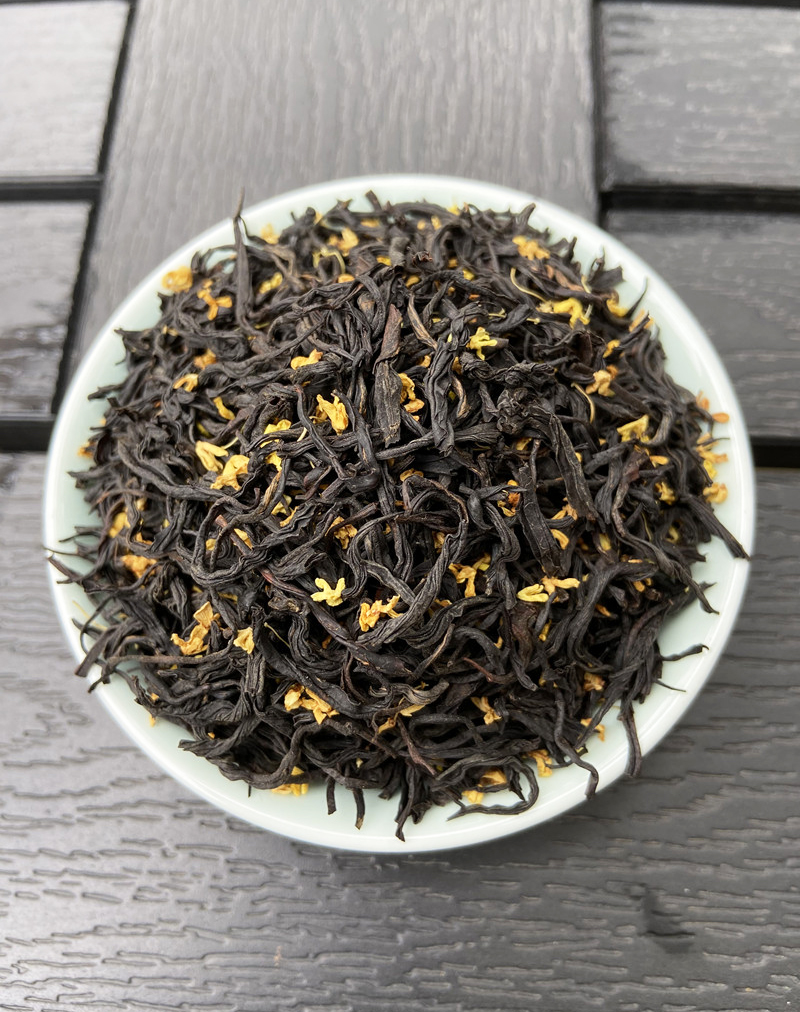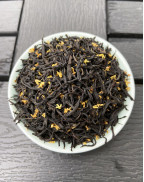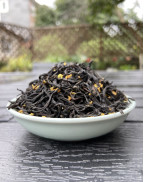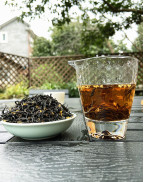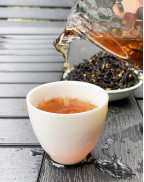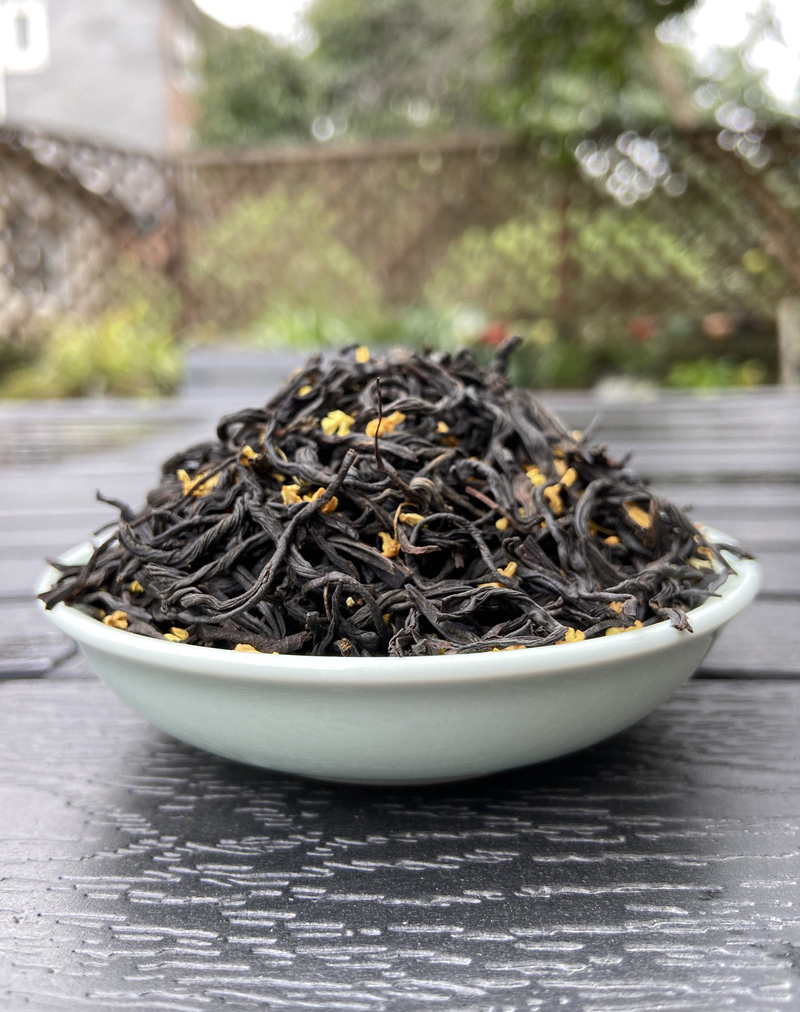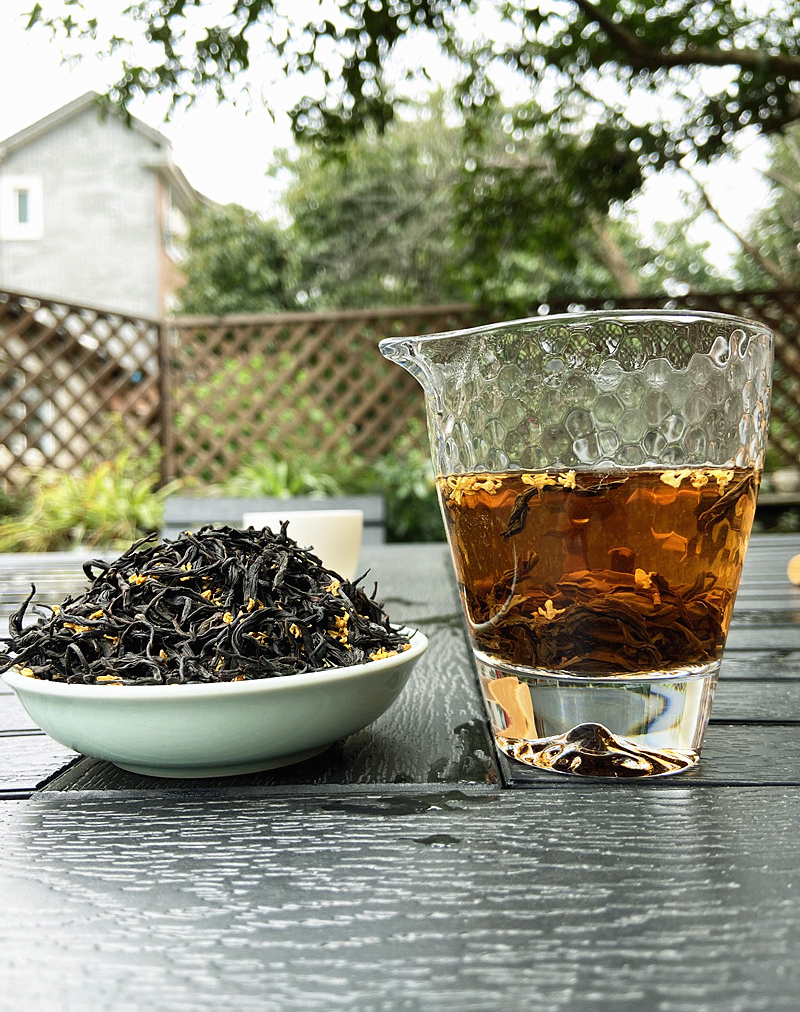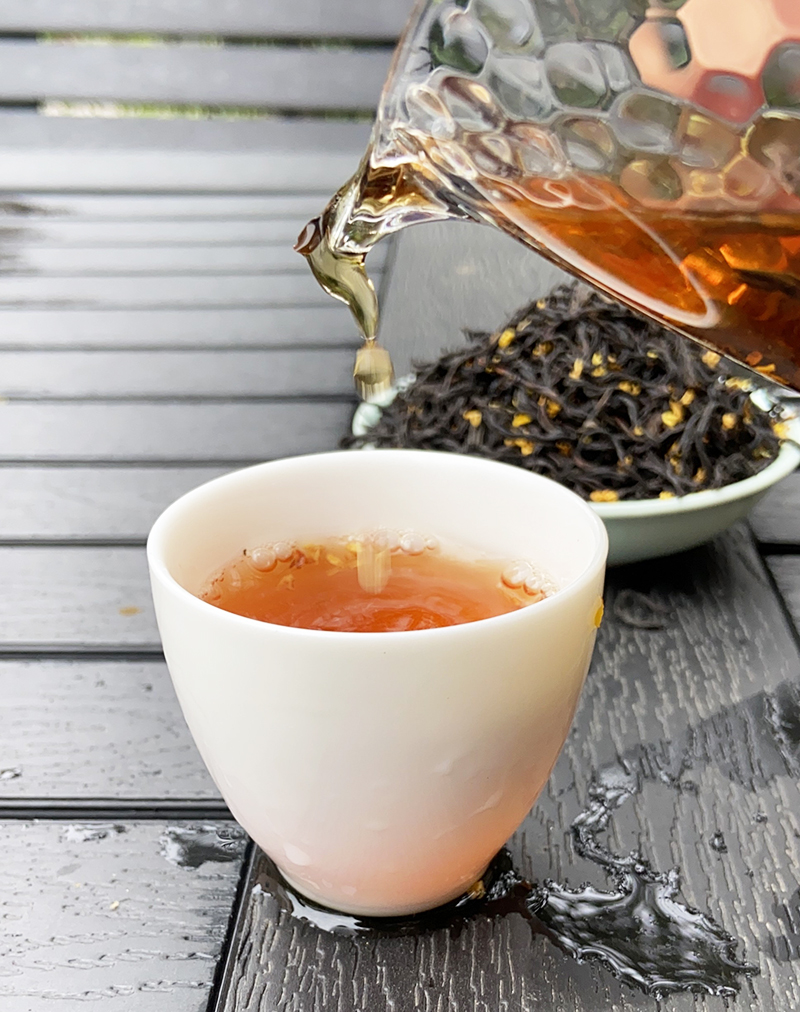Osmanthus Jiu Qu Hong Mei “Red Plum” Black Tea
- Product Code: simple
- Availability: In Stock
Basic Info
Name: Osmanthus Jiu Qu Hong Mei “Red Plum” Black Tea
Other Names:Osmanthus Jiu Qu Oolong
Category: Black Tea
Origin: Hangzhou, Zhejiang
Taste & Aroma: Refreshing, lingering sweetness,Osmanthus fragrance, Long-lasting aftertaste
Liquor: Deep, rich red color
Dry Leaf: Tightly twisted, silver-hook shaped, jet black and oily, with golden tips
Harvest Period: Spring, 2024
Fermentation: 95%
Season: Spring tea
Item Form: Loose leaves
Ingredients: Hand-picked natural tea buds and leaves /100% hand-picked natural tea buds and leaves, Osmanthus
Degree of baking: Roasted moderately
Shelf Life: 24-36 months with low temperature storage
Storage: Stored in cool, airtight, opaque containers
Flavor: Flavored
Sourcing : Teapooo
Caffeine: Low
Osmanthus Jiu Qu Hong Mei “Red Plum” Black Tea
Jiu Qu Hong Mei “Red Plum” Black Tea, also known as “Jiu Qu Oolong,” is a black tea produced in the Xihu District of Hangzhou City, Zhejiang Province. It is made from the tender leaves of green tea varietals and is a famous tea of Zhejiang Province, as well as one of the traditional famous teas of China. Jiu Qu Hong Mei is named after the Jiuqu Ridge in Xihu District where it is produced, and it became famous at home and abroad in the late Qing Dynasty.
Jiu Qu Hong Mei “Red Plum” Black Tea is a tea that is as famous as Longjing Green Tea. The raw materials are also
the same as Longjing Green Tea, using fresh tea leaves from the tea trees in the West Lake production area.
Because the tea making process is different, the same fresh leaves create two different appearances and
tastes.
Jiu Qu Hong Mei is a type of black tea that gets its name from its dark, glossy dry tea leaves and its orange-yellow to reddish-brown tea soup. In addition to being a beverage, Jiu Qu Hong Mei also has a deep historical and cultural heritage. In Hangzhou, Jiu Qu Hong Mei is one of the traditional famous teas with a long history and is known as the “Flower of the West Lake.” Jiu Qu Hong Mei is produced in the area around Jiuqu Ridge in Zhoupu Township, Xihu District, Hangzhou City, Zhejiang Province. It is one of the special products of Hangzhou City, Zhejiang Province, and a Chinese national geographical indication product.
Its place of origin is not Zhejiang Province, but Jiuqu Creek in Wuyi Mountain, Fujian Province. At that time, it was a type of Xiaozhong Gongfu black tea, and its quality was not inferior to the Keemun Black Tea of that time. During the Taiping Heavenly Kingdom period, due to the war, people from Jiuqu Creek migrated to northern Zhejiang, and the production process of Jiuqu red tea was also introduced to Zhejiang Province.

Tea Garden in Hangzhou, Zhejiang
Show Full Description
legend
According to legend, in the Lingyan Dawu Basin, there was an elderly couple who were nearly 60 years old when they finally had a son. They named their son “Along.” One day, Along saw two crayfish fighting over a small pearl and, curious, picked up the pearl and put it in his mouth. Carelessly, he swallowed the pearl. When he got home, he suddenly felt an unbearable itching all over his body and demanded to take a bath. As soon as he got into the bathtub, he turned into a black dragon, flew out of the house, and jumped into the stream, swimming away into the distance. The old couple cried out and desperately chased after him. The black dragon was reluctant to leave his parents and turned its head to look back nine times as it swam away. Thus, a winding stream with nine bends and eighteen turns was formed, leading all the way to the Qiantang River. The legend of the “Jiuqu Wulong” (Nine-Bend Black Dragon) was thus passed down.

The Scenery of West Lake in Hangzhou
Name
Jiuqu Hongmei was first developed by tea farmers from Chong’an County (now Wuyishan City), Nanping City, Fujian Province. Wuyi Mountain has the famous Jiuqu Creek, and the dry tea leaves of this tea are also curved, while the tea soup is as bright as red plums, hence the name “Jiuqu Hongmei.”
History
In the mid-Qing Dynasty, due to war and chaos, many tea farmers from Wuyi Mountain migrated north to the area around Shuangpu Town, Xihu District, Hangzhou, where they reclaimed land on the mountain to grow crops and tea, and used the process of making oolong tea to produce tea products, both for their own consumption and to earn a living. Because the shape of the tea leaves resembled hooks, the tea soup was bright and beautiful, and the tea tasted sweet and full-bodied, this red tea, named “Jiuqu Hongmei” (also known as “Jiuqu Wulong”), became very popular as soon as it appeared on the market and quickly became famous. Jiuqu Hongmei won the gold medal at the Panama World Exposition in 1886.
Origin of Jiuqu Hongmei
Jiuqu Hongmei originated from the Jiuqu of Wuyi Mountain. It is said that during the Taiping Heavenly Kingdom period, tea farmers from Wuyi, Fujian Province, migrated to northern Zhejiang and settled in the Lingyan area, where they reclaimed land farming and planted tea to make a living. Some of the farmers from the south were skilled in making black tea, and the black tea they made was purchased by tea shops and tea companies in Hangzhou, and this tradition has continued to this day. Jiuqu Hongmei tea is one of the 28 famous teas of Zhejiang Province.
Development of Jiuqu Hongmei
After the outbreak of the Anti-Japanese War, Hangzhou fell, and the development of Jiuqu Hongmei entered a low ebb, and it was difficult to recover due to the war. After the founding of the People’s Republic of China in 1949, Jiuqu Hongmei somewhat recovered, but Xihu Longjing Tea, which is also produced in the Xihu District of Hangzhou, was too famous, and Jiuqu Hongmei inevitably had a “moonlight overshadowed by starlight” situation. In recent years, with the continuous expansion and growth of demand for black tea, the production and quality of Jiuqu Hongmei have both improved significantly, and it has entered a new stage of development.
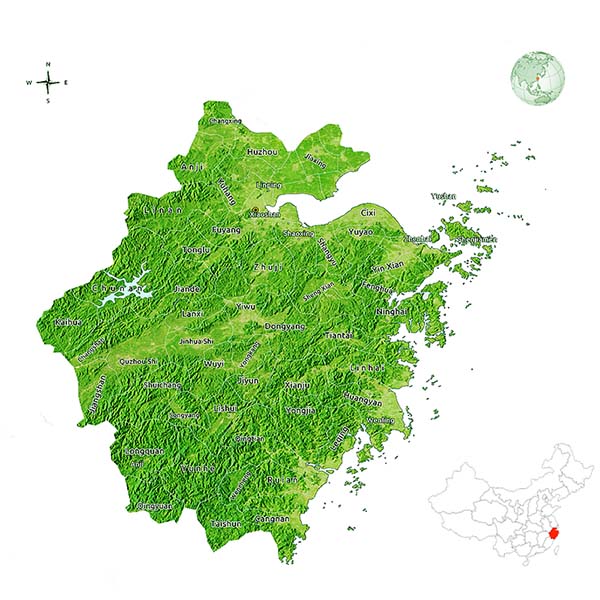
Map of Zhejiang, China
Producing Area
Jiuqu Hongmei tea is produced in the area around Lake Bu, Shuangling, Zhangyu, Fengjia, Shejing, Shangyang, and Renqiao in the southwest suburbs of Hangzhou, by the Qiantang River. The tea produced in Dabu Mountain, Lake Bu is particularly high-quality. Dabu Mountain, Lake Bu is more than 500 meters above sea level, and the top of the mountain is a basin with fertile soil. The surrounding mountains are verdant and lush, providing shelter from the wind and snow and shade from the sun. The mountain is close to the Qiantang River, and the evaporation of the river water creates a misty environment on the mountain, which is ideal for the growth of tea trees and the formation of high-quality tea.
Processing
Jiuqu Hongmei tea is generally picked around the 清明节(Qingming Festival) every year, when the quality of the tea leaves is at its best. The picking standard is tender buds, one bud and one leaf, one bud and two leaves, etc., with the focus on tender buds and one bud and one leaf. The tea leaves used are mainly the new shoots of tea trees before the Qingming Festival, and the quality of the tea leaves will gradually decline after the Qingming Festival.
The processing of Jiuqu Hongmei tea mainly includes the steps of withering, rolling, fermenting, and drying. Withering is the process of spreading the picked tea leaves on a sieve and placing them indoors or outdoors to wither naturally. When the tea leaves reach a certain degree of softness, they are rolled and twisted, so that the tea leaves curl into strip-shaped. Then, they are fermented to accelerate the color change of the tea leaves. Finally, they are dried to make dry tea.
How to make Osmanthus Jiu Qu Hong Mei "Red Plum" Black Tea
Fresh Flower Picking:
Pick fresh osmanthus flowers on a mild and sunny day in early September. Remove impurities and dry in the shade.

The Workers Are Making Jiu Qu Hong Mei
Tea Base and Flower Blending:
Mix the dried osmanthus flowers with Sweet Osmanthus Green Plum dry tea in a ratio of 1:8.
Scenting
Place the blended tea and flowers in layers in a cellar. Alternate layers of tea leaves and flowers, with a final layer of tea leaves on top.
Cellar Management:
During the scenting process, the tea master regularly checks on the tea leaves and turns the pile to help dissipate heat. Adjustments are made based on the temperature and humidity within the tea and flower layers.
Drying and Absorption:
After two rounds of scenting, lasting a total of 72 hours, the tea leaves have absorbed the floral fragrance and
moisture, becoming soft and pliable. Finally, quicklime is used to absorb any remaining moisture from the tea
and flowers, leaving them dry once more. This process also helps the floral and tea aromas to blend and
harmonize.
Characteristics
Osmanthus Sweet Osmanthus Green Plum Tea presents with slender and graceful dry leaves, tightly rolled and as fine as hair, resembling fish hooks in their curvature, and exuding a delicate osmanthus fragrance. Upon brewing, the tea liquor reveals a clear and translucent light orange hue, with visible silvery tips dancing within.

Osmanthus Fragrans
With each subsequent infusion, the tea liquor deepens in color, while the infused floral notes gradually unfurl, creating a sense of invigoration and relaxation. The aromas of osmanthus, honey, and the subtle fragrance of Sweet Osmanthus Green Plum intertwine harmoniously, lingering on the palate and slowly transforming. They seem to float upon the tongue and linger in the throat, leaving a lasting impression.
This tea offers a clear and vibrant liquor, a captivating and enduring aroma, a refreshing and rich flavor, and a lingering aftertaste. The floral notes of osmanthus and the subtle fragrance of Sweet Osmanthus Green Plum blend seamlessly, creating a symphony of flavors that delight the senses and uplift the spirit.
Whether enjoyed as a daily beverage or shared as a thoughtful gift, Osmanthus Sweet Osmanthus Green Plum Tea is an exceptional choice, worthy of savoring and cherishing.
| Chinese Gongfu Method | |
| Tea | 3g |
| Water | Gaiwan 3oz / 90ml |
| Time | 6 infusions: (15s,25s,45s,70s,90s,115s) |
| Temperature | 90℃ / 194℉ |
| Teapot Method | |
| Tea | 5g |
| Water | Teapot (8oz / 240ml) |
| Time | 1- 4mins |
| Temperature | 90℃ / 194℉ |


